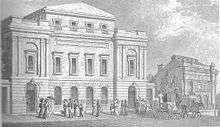Sheffield Medical School
Coordinates: 53°22′41″N 1°29′35″W / 53.378°N 1.493°W
| Type | Medical school |
|---|---|
| Established | 1828 |
| Location | Sheffield, England |
| Affiliations |
University of Sheffield Sheffield Teaching Hospitals NHS Foundation Trust |
| Website | http://www.shef.ac.uk/medicine/ |
The School of Medicine and Biomedical Sciences at the University of Sheffield is a medical school active in three fields of medicine: teaching, researching and practising.

The medical school was founded in 1828. The school operated independently as the Sheffield School of Medicine until its mergers with Firth College in 1879 and with Sheffield Technical School in 1884.[1] In 1897 the schools were renamed University College Sheffield.
The University of Sheffield Medical School is one of 32 bodies entitled by the General Medical Council (GMC) to award medical degrees in the United Kingdom. The GMC is the body responsible for registering doctors to practise medicine as well as regulating medical education and training in the United Kingdom.[2]
Applying for a place to study Medicine at Sheffield is competitive. As of 2013 the medical school admits some 214 home students and a further 23 overseas students per year.[3] For entry in 2013 the school received over 3,000 applications.[4]
Research

The school's research focuses in seven areas, cardiovascular science; endocrinology and reproduction; infection, inflammation and immunity; musculoskeletal science; neuroscience; oncology; and primary care and ageing.[5]
The school has been associated with a number of notable medical discoveries.[1] In the 1920s, Edward Mellanby's studies on rickets established that cod liver oil prevented the disease, which helped lead to its eradication. In the 1930s, Cecil Payne became the first to use Penicillin to effect a cure. Also in the 1930s, Sir Hans Krebs made significant advancements in the study of cellular energy, codifying his observations in the Krebs Cycle, for which work he received a Nobel Prize in 1953.
References
- 1 2 Sheffield Medical School. "History and Background". shef.ac.uk/medicine. Retrieved 1 August 2010.
- ↑ "www.gmc-uk.org General Medical Council". gmc-uk.org. Retrieved 1 August 2010.
- ↑ "www.ukmedicalschools.com UK Medical School Statistics". ukmedicalschools.com. Archived from the original on 4 December 2008. Retrieved 8 September 2008.
- ↑ http://www.shef.ac.uk/medicine/prospective_ug/applying
- ↑ Sheffield Medical School. "Research". shef.ac.uk/medicine. Retrieved 2 August 2008.
